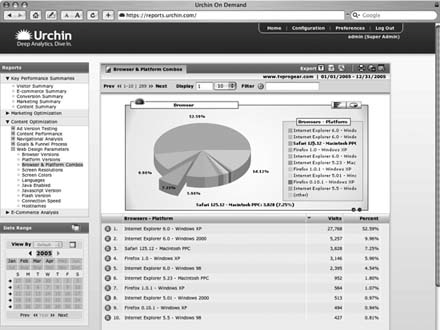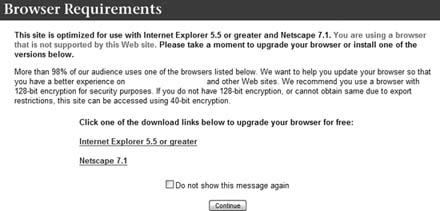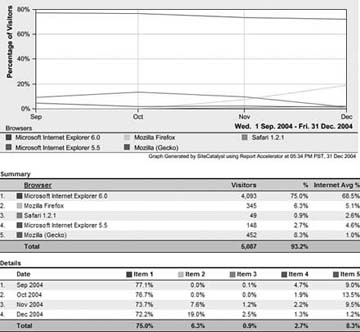Hack71.Know How to Use Browser Version Information
Hack 71. Know How to Use Browser Version Information
Make sure you're performing application quality assurance testing for the browser versions that your visitors are actually using. Web application developers have learned to fear final-stage application testing for multiple browser versions and platforms. The basic fear is that you spend a great deal of time writing complex code, usually JavaScript and dynamic HTML, for a single browserusually the dominant version of Internet Explorer at the timebut when all is said and done, the code won't run in Netscape, Opera, Macintosh's Safari, or Firefox. Smart web quality assurance managers know that your web measurement application already reports on the information you need to build a browser plan. Like other technographic reports, browser type and browser version reports are pretty much standard (Figure 5-7). Unfortunately, these reports often go unused, but it doesn't have to be this way. Three things you can do to take advantage of your browser versions report include build for your top five browsers, pay attention to emerging trends, and monitor the Internet averages (if possible). 5.5.1. Build for Your Top Five BrowsersNotice the word "your" in the sentence aboveyou should focus your quality testing on the browsers that your visitors actually use when they visit your web site. Until recently people's browser choice had been pretty much made for themWindows people used Internet Explorer, Macintosh people used Safari, and Unix people, well, they were probably using some version of Netscape or Mozilla. While people would upgrade browser versions, few switched browser platforms completely, at least until recently You want to closely examine your browser versions report to make sure your testing plan is built around the top five browsers people use when they visit your site. For my site (Figure 5-7), I will be focusing on Internet Explorer 6.0, Firefox 1.0, Safari 1.2.1, Internet Explorer 5.5, and Mozilla Gecko. Despite the fact that the last three browser versions add up to only five percent of my visiting traffic, I want to pay close attention to these applications to be sure that they don't create any complications so that if I attract more visitors using these platforms, or if they magically surge in Internet-wide popularity, I'll be set. Figure 5-7. Browser version by operating system report Why? Because the worst thing you can possibly do to a visitor or loyal customer is show them a message like the one in Figure 5-8 when they try and update a 401K plan. If, by chance, you still have a browser version that is being used by more than five percent of your visitors after you consider the top five, make sure and add those browsers to the test plan as well. When examining browser versions, look at data from the last 90 days: that's enough time to gather meaningful data but not enough to dilute emerging trends. 5.5.2. Pay Attention to Emerging TrendsTo reinforce the assertion that you should examine the last 90 days and consider the top five browser versions even if your traffic volume is low for some of those browsers, you should also get in the habit of looking at a trended view of the data (Figure 5-9). Figure 5-8. Annoying browser requirements error message Figure 5-9. Browser versions over time The trended view of the data will help you better plan for the future. In the case of Figure 5-9, it is clear that it makes more sense to pay closer attention to Firefox, and less to Mozilla Gecko (or possibly even consider dropping Mozilla Gecko from the test plan entirely). While it's rare that a new browser will emerge and create a situation in which 0.0 percent of visitors are using Firefox in October 2004, 7.6 percent in November 2004, and 19.0 percent in December 2004, this is the exact data and presentation that will save your QA team time and effort in the long run. 5.5.3. Monitor Internet AveragesFinally, you want to keep an eye on an Internet-wide report of browser version use if possible. Offered by companies like Holland's OneStat (www.onestat.com) and WebSideStory's StatMarket (www.websidestory.com) and occasionally embedded in web measurement applications (see the "Internet Average Percentage" column from Omniture's SiteCatalyst 11 in Figure 5-4 and Figure 5-7), this data can help you understand how your visitor audience differs from the teeming masses of Internet users.
This statement is bound to be controversial, and your QA manager may argue this point until she is red in the face, so here's a caveat.
There you have it: a reasonable and easy-to-follow plan for taking advantage of the browser version information already reported by your web measurement applications. |
EAN: 2147483647
Pages: 157
- Article 384 Strut-Type Channel Raceway
- Tables 11(A) and 11(B)
- Example No. D2(b) Optional Calculation for One-Family Dwelling, Air Conditioning Larger than Heating [See 220.82(A) and 220.82(C)]
- Example No. D2(c) Optional Calculation for One-Family Dwelling with Heat Pump(Single-Phase, 240/120-Volt Service) (See 220.82)
- Example No. D12 Park Trailer (See 552.47)

